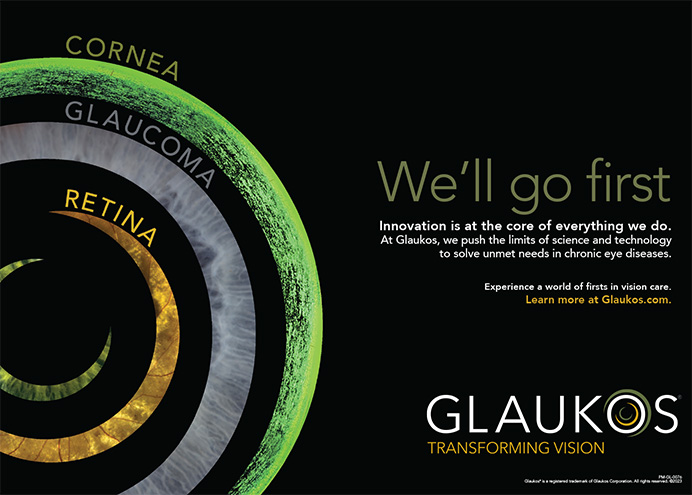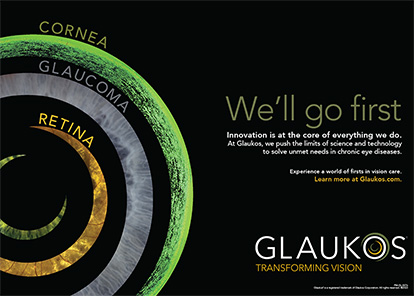

Comparison of Intraoperative Aberrometry, OCT-Based IOL Formula, Haigis-L, and Masket Formulae for IOL Power Calculation After Laser Vision Correction
Fram N, Masket S, Wang L1
ABSTRACT SUMMARY
Fram and colleagues performed a retrospective study of patients with a history of LASIK or PRK who underwent cataract surgery. The researchers compared the refractive outcomes of four different methodologies for IOL power calculation: two newer options, intraoperative aberrometry (ORA System; Alcon) and an optical coherence tomography-based IOL formula (RTVue spectral-domain optical coherence tomography; Optovue), and two conventional methods, the Haigis-L and Masket regression formulae. Because the Masket formula requires historical data, the patients were divided and analyzed separately based on the availability of this information—39 eyes (29 patients) without historical data and 20 eyes (20 patients) with historical data. The standard preoperative biometry was obtained with the IOLMaster 500 (Carl Zeiss Meditec).
The researchers found no statistically significant difference among the methods. Without historical data, 49% of eyes achieved a result within 0.25 D of the target refraction, 69% to 74% within 0.50 D, and 92% to 97% within 1.00 D. With historical data, 35% to 70% obtained an outcome within 0.25 D of the target, 60% to 85% within 0.50 D, and 90% to 95% within 1.00 D. The median and mean absolute error of the methods without historical data was as follows: ORA System, 0.29 D and 0.34 D; Optovue, 0.28 D and 0.39 D; Haigis-L, 0.26 D and 0.37 D. With historical data, the median and mean were as follows: ORA System, 0.25 D and 0.37 D; Optovue, 0.39 D and 0.44 D; Haigis-L, 0.22 D and 0.31 D; Masket, 0.21 D and 0.28 D.
DISCUSSION
With current tools, predicting the correct IOL power in patients with a history of laser vision correction remains challenging but is becoming a more attainable goal. Because altering the anterior corneal curvature changes one of the two fundamental measurements for standard third-generation formulae, different methods are needed to predict the appropriate IOL power. One approach to this challenge has been to create new formulae. Another has been to use new technology to overcome the obstacle.
The literature has been mixed and, at times, contradictory regarding which method seems to provide superior results.2-8 Canto et al were the first to publish results using the ORA System’s predecessor, ORange.2 Their results were highlighted in a prior edition of “The Literature” column and suggested that this technology was better at reaching emmetropia than the current formulae,9 but both that device and the formulae are no longer considered current. The study by Fram and colleagues provides the most up-to-date look at this topic with technology and formulae that are in use today.
Interestingly, although this study’s outcomes suggest improved outcomes with the technology compared to prior research, the formulae perform just as well. In fact, although not statistically significant, for patients with historical data, the Masket regression formula trended toward better refractive outcomes. This study is limited by the sample size, but it raises the idea that using new technology may not produce better refractive outcomes after cataract surgery in patients with a history of laser vision correction. More research is needed on this topic, because the number of these individuals needing cataract surgery continues to increase.
Intraocular Lens Power Selection and Positioning With and Without Intraoperative Aberrometry
Hatch KM, Woodcock EC, Talamo JH10
ABSTRACT SUMMARY
Hatch and colleagues retrospectively analyzed the amount of residual refractive astigmatism after the placement of a toric IOL. They compared “standard” lens prediction and placement methods (n = 27) to those aided by the use of the ORA System (n = 37). All patients received the same preoperative evaluation.
IOL power was predicted using the Hoffer Q formula for eyes with an axial length of less than 23 mm and the SRK/T formula for eyes with an axial length of 23 mm or greater. The cylindrical power and axis for the IOL’s placement were predicted by industry’s online calculators, neither of which factors in corrections of posterior corneal astigmatism. Patients’ corneal axes were marked with a Mendez axis marker while the patients were sitting upright. For the aberrometry group, aphakic measurements were performed intraoperatively to adjust spherical and cylindrical powers. After placement of the IOL, pseudophakic measurements were performed to adjust rotation of the lens axis.
The study found lower postoperative residual astigmatism in the aberrometry group (0.46 vs 0.68 D) as well as a greater percentage reduction in astigmatism (75% vs 57%). Aphakic intraoperative aberrometry readings changed the predicted cylindrical power 24% of the time and spherical power 35% of the time. Pseudophakic measurements showed that no rotations were needed in 68% of cases; 92% needed three or fewer rotations, and 8% required more than three rotations. A distance UCVA of 20/25 or better was achieved in 67% of the aberrometry group compared with 39% of the control group.
Discussion
Several studies have shown the superiority of toric IOLs compared with limbal relaxing incisions,11-13 but there are challenges to implanting these lenses. First, the effective lens position affects the magnitude of cylindrical correction, specifically in highly myopic eyes. Second, surgeons are currently unable to directly measure posterior corneal cylinder, which influences both the magnitude and alignment of astigmatic correction.14 According to Euler’s theorem, just a few degrees of axial misalignment can markedly decrease the effectiveness of toric correction. Tools to help reduce some of these variables are needed. This study suggests that intraoperative aberrometry could help to decrease residual astigmatism.
It should be noted that the investigators did not attempt to correct for posterior corneal astigmatism in their preoperative calculations. Koch’s nomogram and/or the Barrett toric calculator are means by which to estimate this factor. It would be useful if future research attempted to take posterior corneal astigmatism into account so as to better isolate how helpful aberrometry can be in toric IOL cases.
Also worth noting is that the investigators chose spherical power limiting themselves to two third-generation formulae. Although 35% of spherical powers were changed, it would be interesting to see how new formulae perform. An intriguing metric this study offers is the frequency with which intraoperative aberrometry suggested axial adjustments. It is interesting that, in 68% of cases using manual marking and axial determination, no adjustment was required.
This study suggests the promise of intraoperative aberrometry for assessing and potentially adjusting preoperative calculations and the lens’ axial alignment. Future research is needed to determine the magnitude of this help compared with modern IOL power and toric selection formulae. This information will be particularly useful to surgeons contemplating implementing the new technology.
1. Fram NR, Masket S, Wang L. Comparison of intraoperative aberrometry, OCT-based IOL formula, Haigis-L, and Masket formulae for IOL power calculation after laser vision correction. Ophthalmology. 2015;122(6):1096-1101.
2. Canto AP, Chhadva P, Cabot F, et al. Comparison of IOL power calculation methods and intraoperative wavefront aberrometer in eyes after refractive surgery. J Refract Surg. 2013;29(7):484-489.
3. Ianchulev T, Hoffer KJ, Yoo SH, et al. Intraoperative refractive biometry for predicting intraocular lens power calculation after prior myopic refractive surgery. Ophthalmology. 2014;121(1):56-60.
4. McCarthy M, Gavanski GM, Paton KE, Holland SP. Intraocular lens power calculations after myopic laser refractive surgery: a comparison of methods in 173 eyes. Ophthalmology. 2011;118(5):940-944.
5. Tang M, Wang L, Koch DD, et al. Intraocular lens power calculation after previous myopic laser vision correction based on corneal power measured by Fourier-domain optical coherence tomography. J Cataract Refract Surg. 2012;38(4):589-594.
6. Wang L, Tang M, Huang D, et al. Comparison of newer intraocular lens power calculation methods for eyes after corneal refractive surgery. Ophthalmology. 2015;122(12):2443-2449.
7. Wang L, Hill WE, Koch DD. Evaluation of intraocular lens power prediction methods using the American Society of Cataract and Refractive Surgeons post-keratorefractive intraocular lens power calculator. J Cataract Refract Surg. 2010;36(9):1466-1473.
8. Yang R, Yeh A, George MR, et al. Comparison of intraocular lens power calculation methods after myopic laser refractive surgery without previous refractive surgery data. J Cataract Refract Surg. 2013;39(9):1327-1335.
9. Liu J, Farid M. The literature. CRST. July 2014;14(7):16. http://crstoday.com/pdfs/crst0714_literature.pdf. Accessed May 18, 2016.
10. Hatch KM, Woodcock EC, Talamo JH. Intraocular lens power selection and positioning with and without intraoperative aberrometry. J Refract Surg. 2015;31(4):237-242.
11. Kessel L, Andresen J, Tendal B, et al. Toric intraocular lenses in the correction of astigmatism during cataract surgery: a systematic review and meta-analysis. Ophthalmology. 2016;123(2):275-286. doi:10.1016/j.ophtha.2015.10.002.
12. Lam DKT, Chow VWS, Ye C, et al. Comparative evaluation of aspheric toric intraocular lens implantation and limbal relaxing incisions in eyes with cataracts and ≤3 dioptres of astigmatism. Br J Ophthalmol. 2016;100(2):258-262.
13. Leon P, Pastore MR, Zanei A, et al. Correction of low corneal astigmatism in cataract surgery. Int J Ophthalmol. 2015;8(4):719-724.
14. Koch DD, Ali SF, Weikert MP, et al. Contribution of posterior corneal astigmatism to total corneal astigmatism. J Cataract Refract Surg. 2012;38(12):2080-2087.
Section Editor Edward Manche, MD
• director of cornea and refractive surgery, Stanford Laser Eye Center, Stanford, California
• professor of ophthalmology, Stanford University School of Medicine, Stanford, California
• edward.manche@stanford.edu
Michael V. Stock, MD
• senior resident, Washington University Department of Ophthalmology and Visual Sciences, St. Louis
• stockm@vision.wustl.edu
• financial interest: none acknowledged
Linda M. Tsai, MD
• comprehensive ophthalmologist with a focus on cataract, glaucoma, and refractive surgery at Washington University Department of Ophthalmology and Visual Sciences, St. Louis
• associate professor at Washington University Department of Ophthalmology and Visual Sciences, St. Louis
• (314) 362-3937; tsai@vision.wustl.edu
• financial interest: none acknowledged


